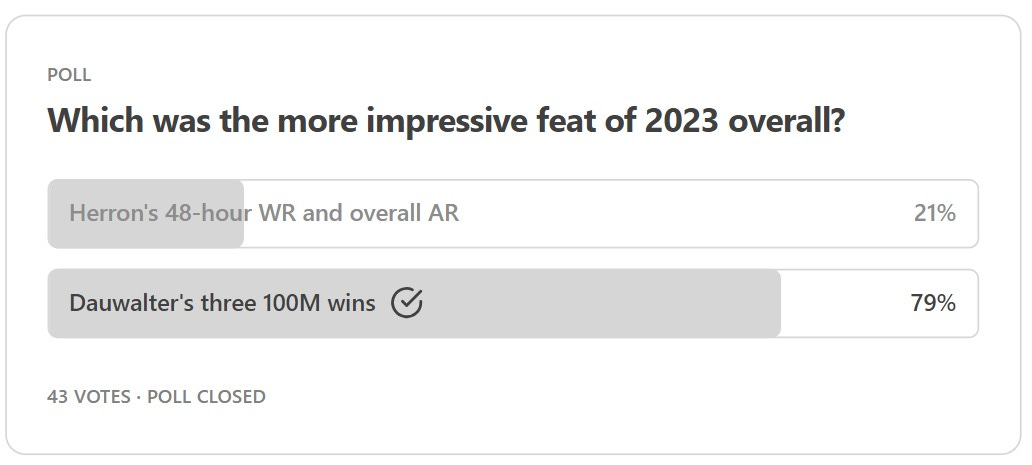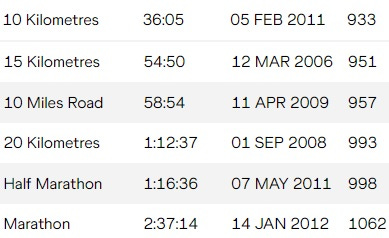Dauwalter vs. Herron poll results
It looks like I agree with the vast majority of Americans, at least when it comes to the important stuff that shapes our everyday lives
I didn’t forget about the poll I posted nearly two weeks ago; I just stopped caring about that and everything, and have been haunted ever since by the idea that I might relapse into giving a shit about something at a vulnerable and unpredictable time. Nevertheless, it’s time to wrap that one up.
The response rate—that is, the total number of poll responses divided by the number of views the post received—was well under 10 percent. I don’t know if this figure is typical for Substack polls, but it seems low, and I blame this on a woefully unbalanced combination of four major factors:
I didn’t pin the post to the top of the page. As soon as I set about burying the post under mountains of new bullshit, the responses dropped nearly to zero.
Only subscribers are allowed to answer Substack polls. The poll post evidently wasn’t shared on social media or anywhere else—thankfully, almost none of these posts receive such treatment—so I don’t think this was much of an issue.
Almost no one gives a shit. This probably accounts for 97 to 99 percent of the low (or so it seems) response rate.
The correct answer was obvious. Almost everyone who saw and briefly considered the poll question chose wisely; only about one in five respondents managed to somehow fuck up an opinion poll.
I agree with the herd here. My reasoning was fairly simple. For one thing, Courtney Dauwalter was racing others in her three efforts, while Camille Herron was “merely” trying to catch up to a number and technically didn’t have to “finish” anything.
Someone can be 85 miles into a 100-miler and holding a huge lead, yet wind up not only losing the race but failing to even finish. While this may not happen all that often, the threat of is always there. Those who answered the poll correctly and who have been in this grotesque and fearful position likely incorporated this thinking into the formation of their responses (I never raced, or ran, longer than 50K in one shot myself, and that one finish was a 2004 sea-level road race that barely counts as an ultramarathon).
What Herron did is as impressive as her other “How much distance can someone cover in a fixed time frame” efforts. It’s interesting to see someone who, depending on race-specific incentives, appears to be at least as driven to set records of this type as she is to shoot for race wins.
Herron was born to do what she most often does. She loves racking up endless miles at a slow pace and has gotten a great deal out of her fairly limited talent. As soon as she realized she was never going to be a truly elite marathoner, she moved up in distance. If she needs to, she’ll do that again.
Herron will run for as long as it takes to break a new record (and, whenever possible, win a race, one with a finish line that’s in the same place for everyone in the field). And while she’s clearly got a sizable ego, Herron, unlike patently insufferable goobers such as Dane Rauschenberg and Dean Karnazes, didn’t start simply inventing invents for herself to “win.” And if she’s ever told any lies, she hasn’t bullshitted like either of those two clowns.
Dauwalter night not be able to hang with Herron in a flat track race of any duration, although it’s unjustified to do more than speculate about this. But I’m not surprised the results were as skewed as they were. Something about Dauwalter winning these three races felt monumental, perhaps unlikely to be duplicated for decades or more (and soon, there won’t be any non-privatized forested land in which to stage these contests anyway; waddle on in the woods, friends, while you still can). Herron, on the other hand, is almost assured of setting more records within six months.
This is a crude way of looking at it, but if these two women were NBA superstars, Dauwalter would be more of a Kevin Durant type, while Herron is more reminiscent of Steph Curry. Both have been associated with championship-winning teams, but the oft-traded Durant—who lists himself at 6’ 9” despite being close to two inches taller—had a broader repertoire of dangerous skills in his prime , while Curry—who’s played for the Golden State Warriors for his entire career—was at his peak a marvel of long-bomb and free-throw-line accuracy as well as a paragon of reliability regarding his shooting stats. You obviously wouldn’t leave either man out of the Naismith Basketball Hall of Fame, but even though they play the same sport, you can’t really compare them in ways that don’t feel slippery because they’re not playing the same role within that sport.



